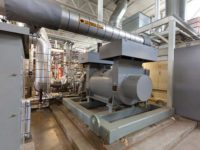In today’s rapidly evolving industrial landscape, sustainable practices and environmental concerns have taken center stage. Industries are under increased pressure to minimize their carbon footprint while ensuring efficient operations. As the demand for greener technologies rises, innovations in boiler technologies, such as low/ultra-low nitrogen oxides (NOx) burners and selective catalytic reduction (SCR) systems, are constantly being deployed and improved upon.
The Evolution of Green Boiler Technology — Traditional industrial boilers have long been notorious for their high emissions of harmful pollutants which include NOx, carbon monoxide (CO), sulfur oxides (SOx), and particulate matter (PM). Due to the severe health risks associated with these pollutants, they are strictly monitored and controlled across all air districts in the country.
Modern green boilers are designed with advanced combustion techniques and state-of-the-art components to drastically reduce such emissions. These boilers optimize fuel combustion, constantly optimize output to match demand, and monitor input/output variables so that operators can keep a close track on operational parameters in one place.
The other cornerstone of green boiler technology is the integration of SCR systems. SCRs use a catalyst to convert NOx emissions into harmless nitrogen and water through a chemical reaction in the presence of a catalyst.
Selective Catalytic Reduction (SCR) — Selective catalytic reduction is a flue-gas emission control process that converts NOx into nitrogen (N2) and water (H2O).

The reduction reaction is achieved using a catalyst to assist in creating the desired reaction between the reducing agent and the NOx of the flue gas. The most common reductants are anhydrous ammonia, aqueous ammonia, and urea. These reductants are injected into the flue gas stream in such a way to promote a homogenous mixture before coming in contact with the catalyst. As the flue gas and ammonia mixture passes through the catalyst, the following reactions occur to produce the intended result of N2 and H2O:
4NO + 4NH3 + O2 → 4N2 + 6H2O
2NO2 + 4NH3 + O2 → 3N2 + 6H2O
NO + NO2 + 2NH3 → 2N2 + 3H2O
While further considerations, such as exhaust temperature, determine the catalyst and other specifications of a SCR system, these systems can work with boilers of almost all sizes to deliver a NOx reduction of up to 95% in some cases.
Heat Recovery — A significant amount of heat (and energy) is left unused in standard boilers due to either design or operational constraints. An exhaust heat recovery system, such as a flue gas economizer in the stack of a boiler, uses residual heat in the exhaust and redirects it to increase the temperature of incoming boiler feedwater. Significant savings can be achieved using the system, as fuel usage goes down by 1% for every 10°F rise in feedwater temperature. A boiler with a standard economizer is usually 3%-5% more efficient than a similarly sized boiler without an economizer. Depending on boiler size and economizer type, over a few months or years of use, the savings in fuel costs can be significant and can easily exceed the investment cost of the economizer.
Boiler Control/Monitoring — While the safeties on boilers are responsible for ensuring safe operation and protection from over-pressurization in emergency conditions, advanced boiler control systems bring unparalleled value to the operations (and operators) of a boiler. With a dedicated boiler controls system equipped with sensors placed throughout the steam system, boiler operators can get operational data that can help them optimize boiler performance in real time.
Key measurements, such as boiler stack temperature, boiler feedwater pressure, and deaerator tank temperature, can also prove to be of immense value to recognize early signs of bigger problems. Such metrics can help operators quickly diagnose small issues before they snowball into bigger problems that might require expensive repairs or shutdowns.
Alternate Fuels/Alternate Boilers — One way to reduce emissions is to simply remove them from the input, i.e., using greener fuels or fuels generated from renewable sources that reduce the total greenhouse gas emissions into the atmosphere. Today, specially designed burners can run on most available biofuels, hydrogen, and hydrogen-natural gas blends. While it’s true a significant capital investment is needed to retrofit steam systems to transition them to these fuels, it’s almost certain that with ever-tightening emissions standards it would be the status-quo in the near future.
Another solution is the use of electric boilers, which completely circumvent the direct greenhouse gas emissions problems. However, care should be taken to account for the indirect emissions related to electricity production if you report and track your emissions. While these can seem to be a panacea, it is extremely rare that most facilities have the extensive infrastructure needed to support the heavy current loads these boilers demand.
Conclusion — Powerhouse has had diverse experience in designing and installing complex steam systems to comply with the toughest emissions requirements. The company’s portable SCR solutions and low/ultra-low NOx boilers are ready to be shipped within hours.
By Neeraj Meghani, product marketing specialist, Atlas Copco







